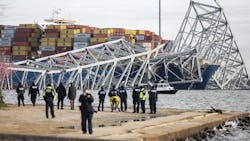NTSB Investigating Key Bridge Collapse
The National Transportation Safety Board (NTSB) has launched an investigation into the Francis Scott Key Bridge collapse in Baltimore. The investigation will include what preventative measures could have been taken.
Terrorism has been ruled out as a cause, and Maryland Gov. Wes Moore said at a news conference Tuesday that the collision seems to have been accident from the information officials already have obtained.
Investigators appear to have attributed the collision in part to a power issue reported by the crew onboard the container ship Dali just before impact.
“What we do know is a bridge like this one, completed in the 1970s, was simply not made to withstand a direct impact on a critical support pier from a vessel that weighs about 200 million pounds,” U.S. Transportation Secretary Pete Buttigieg said Wednesday.
DALI was as “wide as the bridge was tall,” said Benjamin W. Schafer, the Willard and Lillian Hackerman Professor of Civil and Systems Engineering at Johns Hopkins University.
“Take a ship that’s as big as a bridge and run it into it,” Schafer told CNN, “and the bridge isn’t going to win.”
According to officials, the ship was leaving the Port of Baltimore and was bound for Sri Lanka. However, moments before the impact, the ship lost propulsion and dropped its anchor.
“As a result, it was unable to maintain the desired heading and collided with the Francis Scott Key Bridge,” a statement from the Maritime Port Authority of Singapore said.
The crew informed authorities of a technical problem just before the crash, warning them in a “mayday” call of what he called a power issue. That allowed authorities to stop more vehicles from crossing the bridge.
Clay Diamond, executive director of the American Pilots Association, described the power issue as a “total blackout” of engine and electrical power. While the lights on the ship were seen turning back on – likely due to an emergency generator – the engines never recovered, Diamond said.
The NTSB is aware of the reported power issues, Chairwoman Jennifer Homendy said in a news conference Tuesday, but the agency would work toward verifying that as part of their own investigation.
A construction crew was on the bridge Tuesday morning before the incident, repairing potholes, Maryland Transportation Secretary Paul Wiedefeld said. But the bridge had no known structural issues, Moore said at Tuesday’s news conference, calling it “fully up to code.”
Aside from determining what happened on the ship, the NTSB will be assessing the structure of the Francis Scott Key Bridge, its construction, and whether there were other measures that should have been in place to prevent this from happening.
Two such measures would be “dolphins” and “fenders,” structures aimed at redirecting ship traffic and protecting the bridge by absorbing the impact of a collision. Experts indicated the Key Bridge appeared to have dolphins, while photos taken before the bridge collapse suggested a lack of fenders, which would shield the columns themselves.
------------------------------------------
Source: CNN
